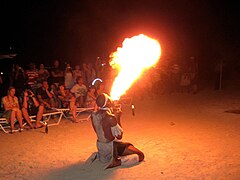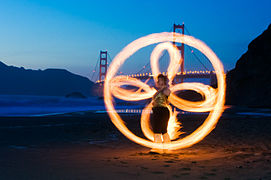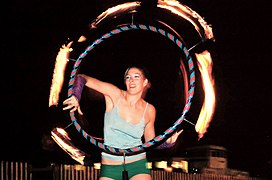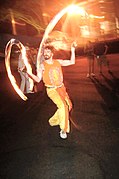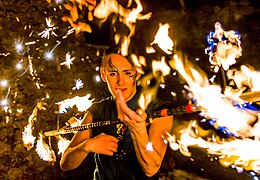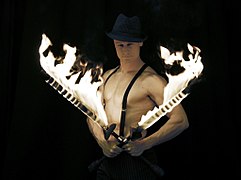
A torch is a stick with combustible material at one end which can be used as a light source or to set something on fire. Torches have been used throughout history, and are still used in processions, symbolic and religious events, and in juggling entertainment. In some countries, notably the United Kingdom and Australia, "torch" in modern usage is also the term for a battery-operated portable light.
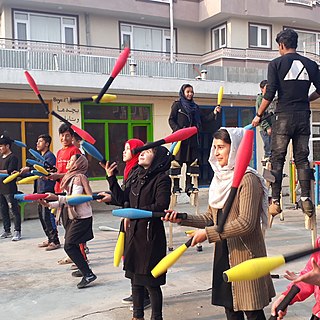
Juggling is a physical skill, performed by a juggler, involving the manipulation of objects for recreation, entertainment, art or sport. The most recognizable form of juggling is toss juggling. Juggling can be the manipulation of one object or many objects at the same time, most often using one or two hands but other body parts as well, like feet or head. Jugglers often refer to the objects they juggle as props. The most common props are balls, clubs, or rings. Some jugglers use more dramatic objects such as knives, fire torches or chainsaws. The term juggling can also commonly refer to other prop-based manipulation skills, such as diabolo, plate spinning, devil sticks, poi, cigar boxes, contact juggling, hooping, yo-yo, hat manipulation and kick-ups.
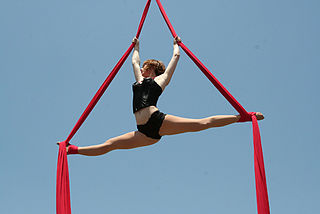
Acrobatics is the performance of human feats of balance, agility, and motor coordination. Acrobatic skills are used in performing arts, sporting events, and martial arts. Extensive use of acrobatic skills are most often performed in acro dance, circus, gymnastics, and freerunning and to a lesser extent in other athletic activities including ballet, slacklining and diving. Although acrobatics is most commonly associated with human body performance, the term is used to describe other types of performance, such as aerobatics.

Arti or Arati is a Hindu ritual employed in worship, part of a puja, in which light is ritually waved for the veneration of deities. Arti also refers to the songs sung in praise of the deity, when the light is being offered. Sikhs also perform arti in the form of artikirtan which involves only devotional singing but Nihang Sikhs specifically perform arti which uses light as well.

Fire breathing is the act of making a plume or stream of fire by creating a precise mist of fuel from the mouth over an open flame. Regardless of the precautions taken, it is always a dangerous activity, but the proper technique and the correct fuel reduces the risk of injury or death.

Fire eating is the act of putting a flaming object into the mouth and extinguishing it. A fire eater can be an entertainer, a street performer, part of a sideshow or a circus act but has also been part of spiritual tradition in India.

Poi is a performing art and also the name of the equipment used for its performance. As a skill toy, poi is an object or theatrical prop used for dexterity play or an object manipulation. As a performance art, poi involves swinging tethered weights through a variety of rhythmical and geometric patterns. Poi artists may also sing or dance while swinging their poi. Poi can be made from various materials with different handles, weights, and effects.
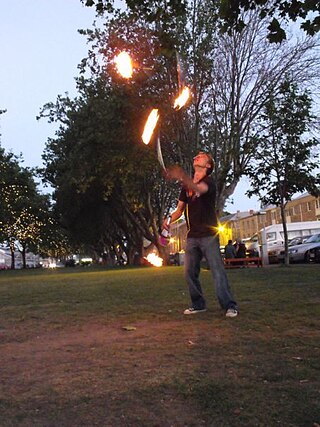
Juggling torches are one of various props used by jugglers. Torches are usually commercially made props that are made of wood and/or metal with a wick attached at one end. The wick is soaked in liquid fuel, usually paraffin and ignited before use.

A fire fan is a fan shaped object usually constructed of non-combustible materials such as welded metal and Kevlar wick that is set alight. They are used for fire performance.
Thiriyuzhichil is a dance ritual performed by Pulluvas in Kerala to alleviate the fear of snakes, to appease the snake and to be blessed with babies. This is more popular in the districts of Trichur, Calicut and Palghat and it is performed in Hindu Temples and shrines meant for snakes. By performing this, the queen of snakes could be appeased. The performer starts dancing holding a torch in his hand using various types of music instruments.

Twirling is a form of object manipulation where an object is twirled by one or two hands, the fingers or by other parts of the body. Twirling practice manipulates the object in circular or near circular patterns. It can also be done indirectly by the use of another object or objects as in the case of devil stick manipulation where handsticks are used. Twirling is performed as a hobby, sport, exercise or performance.
Technora is an aramid that is useful for a variety of applications that require a lot of high strength or chemical resistance. It is a brand name of the company Teijin Aramid.
Hooping is the manipulation of and artistic movement or dancing with a hoop. Hoops can be made of metal, wood, or plastic. Hooping combines technical moves and tricks with freestyle or technical dancing. Hooping can be practiced to or performed with music. In contrast to the classic toy hula hoop, modern hoopers use heavier and larger diameter hoops, and frequently rotate the hoop around parts of the body other than the waist, including the hips, chest, neck, shoulders, thighs, knees, arms, hands, thumbs, feet, and toes. The hoop can also be manipulated and rotated off the body as well. Modern hooping has been influenced by art forms such as rhythmic gymnastics, hip-hop, freestyle dance, fire performance, twirling, poi, and other dance and movement forms.
Object manipulation is a form of dexterity play or performance in which one or more people physically interact with one or more objects. Many object manipulation skills are recognised circus skills. Other object manipulation skills are linked to sport, magic, and everyday objects or practices. Many object manipulation skills use special props made for that purpose: examples include the varied circus props such as balls, clubs, hoops, rings, poi, staff, and devil sticks; magic props such as cards and coins; sports equipment such as nunchaku and footballs. Many other objects can also be used for manipulation skills. Object manipulation with ordinary items may be considered to be object manipulation when the object is used in an unusually stylised or skilful way or for a physical interaction outside of its socially acknowledged context or differently from its original purpose.

A skill toy of Asian origin, the meteor consists of a rope, usually between 5 and 8 feet long, with weights attached to either end. Tricks are performed by swinging, wrapping and throwing the meteor about the body.

A fire staff is a staff constructed out of wood or metal with Kevlar wick added to one or both ends. Fire staffs are used for fire performance.

The closing ceremony of the 2012 Summer Paralympics, also known as the Festival of the Flame, was held on 9 September at the Olympic Stadium in London. Kim Gavin served as director for the ceremony, while Stephen Daldry served as its executive producer. The ceremony was themed around festivals and the four seasons, with the artistic programme being set to performances by British band Coldplay. The band were joined by guests such as the British Paraorchestra, Rihanna, and Jay-Z.






